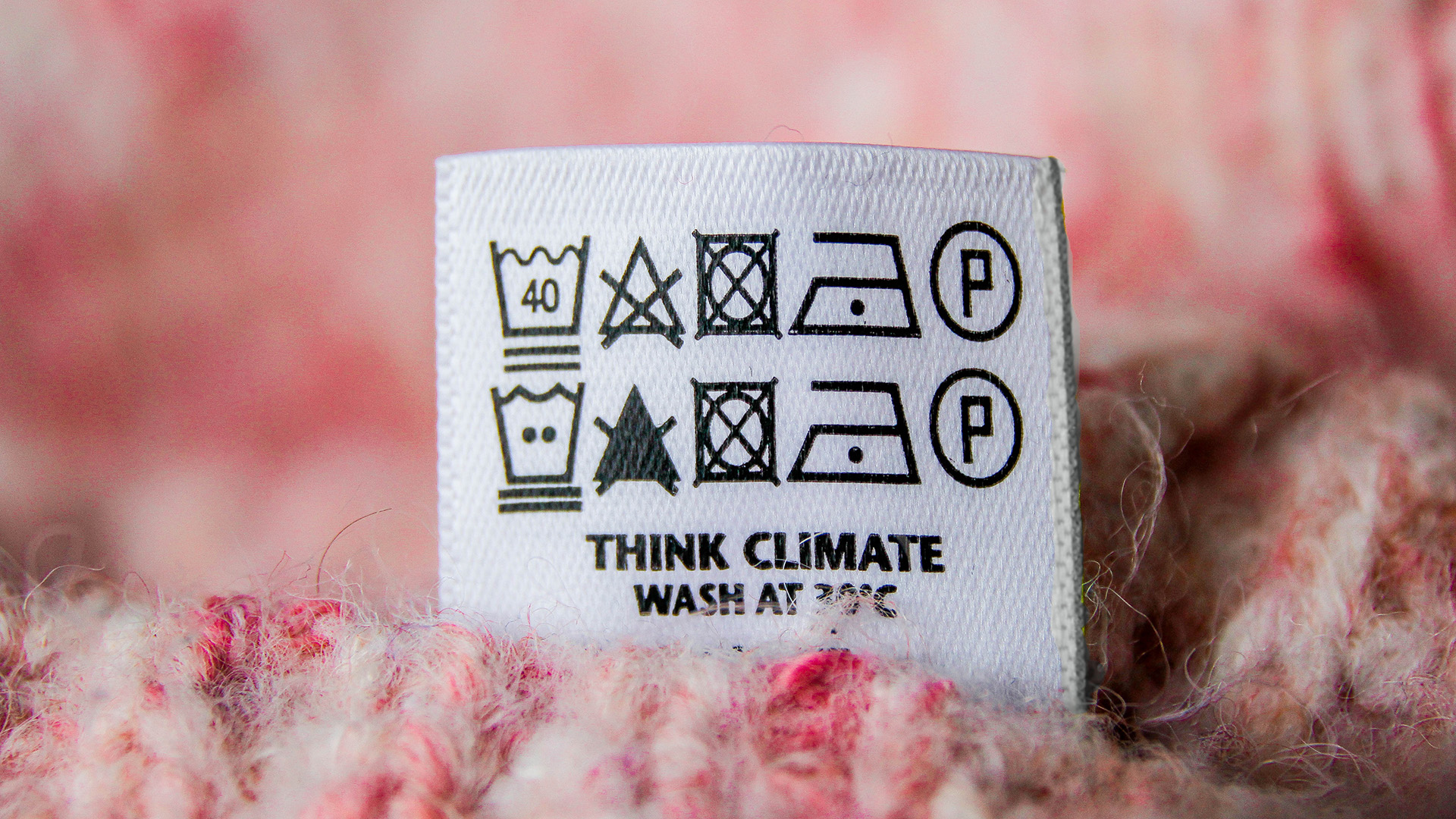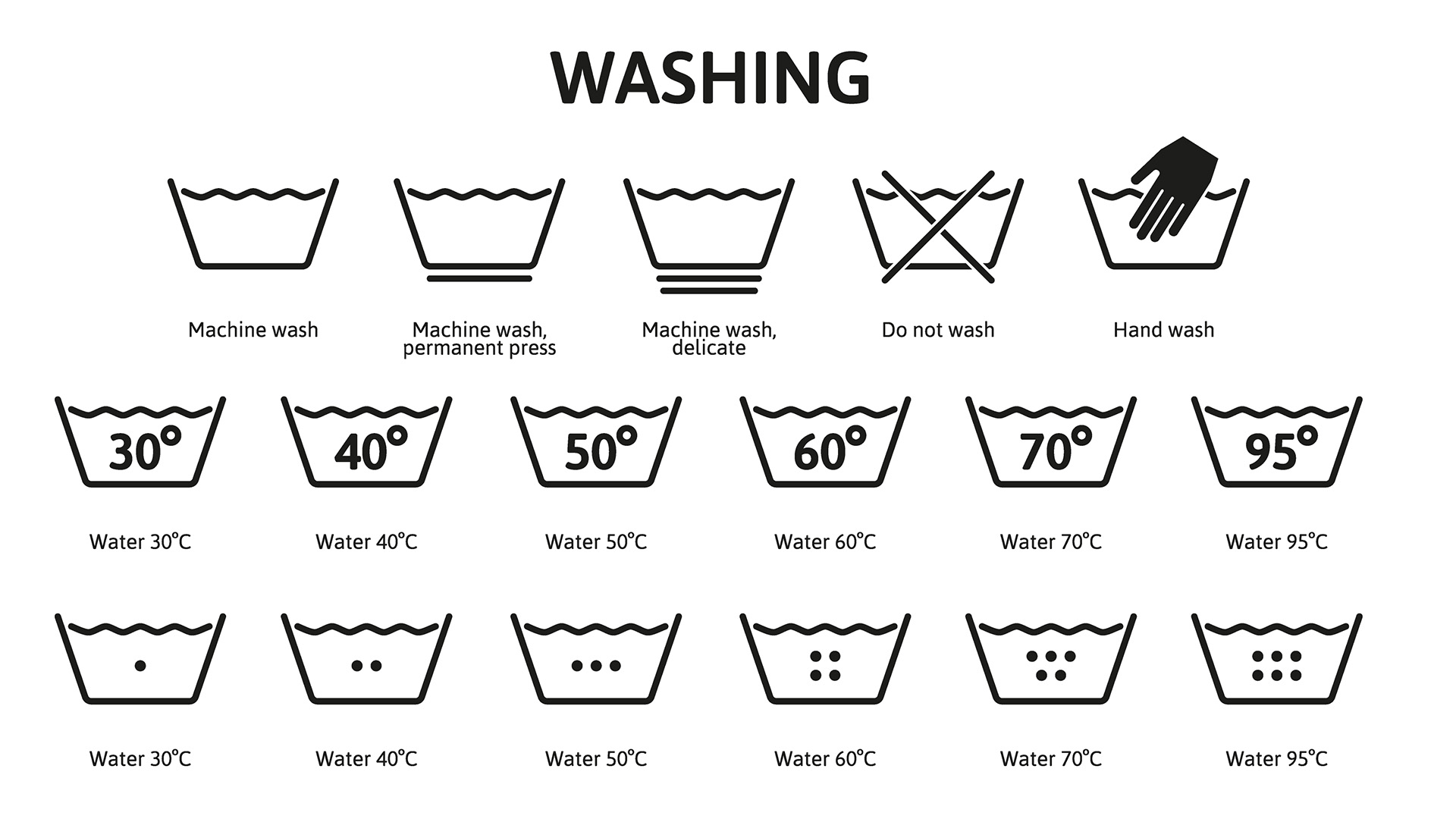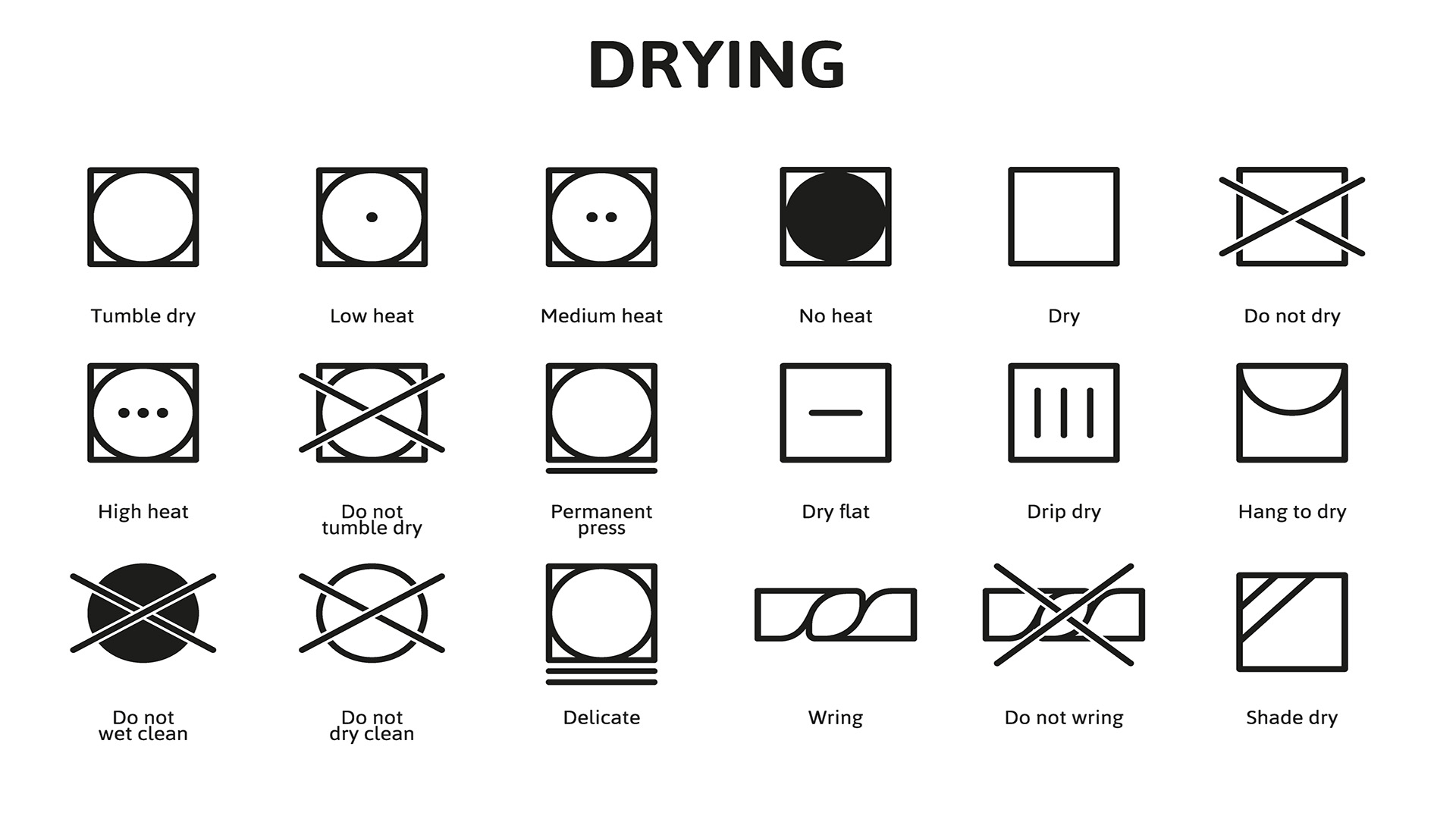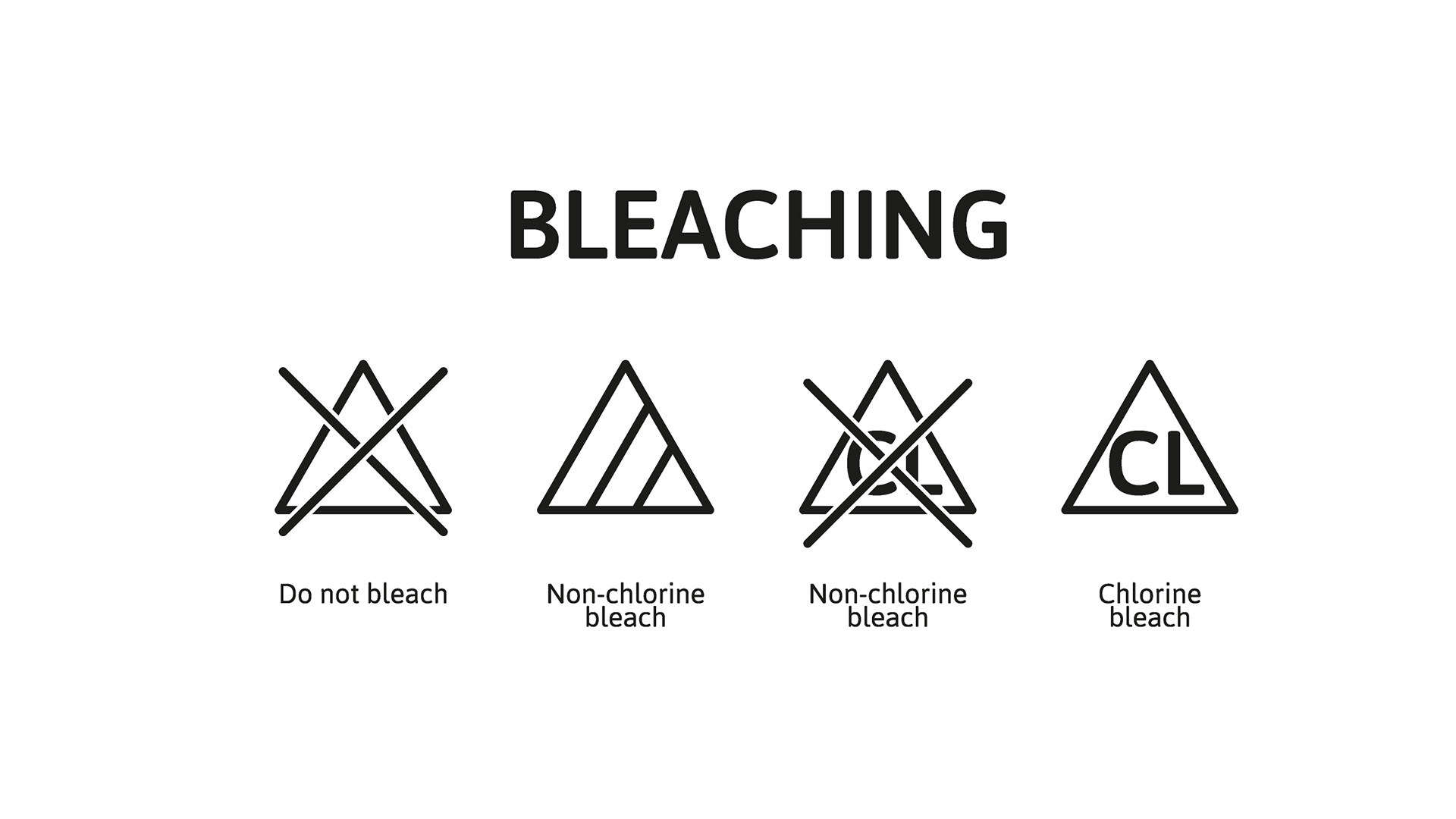What do laundry symbols mean? Discover how to read care labels, and more
Discover how to read your care labels and wash your clothes accordingly for the best results.

The image of laundry symbols might be a convenient way to give you all of the information you require for your washing. Sometimes, however, they can be incredibly difficult to translate, and unfortunately, we're not usually taught what these symbols mean.
Knowing exactly what each symbol means is essential not only for making laundry day as quick and easy as possible but also for making sure your clothes are kept in their best possible condition.
I'm sure most of us have been in a situation where our favorite sweater comes out of the dryer looking like it's designed for a toddler, so it's important to read the care label of every piece of clothing you own. Not only will this save you from throwing away perfectly good clothes, but it will also mean that you're using the correct washer and dryer settings that are best for your wallet and for the environment.
The best washing machines and the best dryers will have dedicated settings such as eco-mode, wool washes, and even sports washes that will have pre-determined timings and temperatures to make laundry that little bit simpler. Regardless of the in-built settings, it's good to read and understand laundry symbols so that you know how to take care of all of your clothes and linens. It's also a good idea to take notice of the best laundry detergents to use, as some items will fare better with dedicated products.
We spoke to Laundry Expert and CEO of MattressNextDay, Martin Seeley, who provided an easy-to-follow laundry symbols guide so that you can easily comprehend exactly which settings to use.

What do laundry symbols mean? Washer symbols
Luckily, once you understand how washer symbols are generated, it's easy to translate the care labels on your clothes. Some will have the number, for example, 30 or 40, written within the symbol so it's easy to quickly check the temperature that's required.
Other symbols might have dots inside, as shown above. This also indicates the water temperature, and they run from one dot all the way up to six dots, with the latter being the hottest temperature. In this case, for one dot you should use cold water, for three dots use warm, and for six you can choose your hottest wash.
Sign up to receive the latest news, reviews, buying guides and deals direct to your inbox
Martin Seeley, laundry expert and CEO of MattressNextDay, has also outlined the general most important symbols to look out for on a care label below.
Washing symbol: This symbol looks like a bucket of water. It indicates the maximum temperature at which the garment can be washed.
Bleaching symbol: This symbol looks like a triangle. It indicates whether the garment can be bleached or not. If the symbol is empty, the garment cannot be bleached. If the symbol has lines in it, it indicates the type of bleach that can be used.
Drying symbol: This symbol looks like a square with a circle in the middle. It indicates whether the garment can be tumble-dried or not. If there is a dot in the middle, it indicates the temperature setting that should be used.
Ironing symbol: This symbol looks like an iron. It indicates the maximum temperature at which the garment can be ironed.
Dry cleaning symbol: This symbol looks like a circle. It indicates whether the garment can be dry-cleaned or not. If there is a letter inside the circle, it indicates the type of solvent that should be used.

What do laundry symbols mean? Dryer symbols
Drying is commonly where the biggest laundry mistakes occur. Putting materials such as wool in a dryer is one of the fastest ways to cause shrinkage, and it's more than disappointing to find your best worn-in sweater suddenly half the size.
If in doubt, try to leave clothes to air-dry, but we know this isn't always achievable. Whether you need to dry work shirts quickly or your clothes aren't drying well in winter months, you might need to make use of your dryer. If so, Martin has a comprehensive list of the most important dryer symbols below.
Tumble drying symbol: This symbol looks like a square with a circle inside. It indicates whether the garment can be tumble-dried or not. If the symbol has a dot in the middle, it indicates the temperature setting that should be used. A single dot means low heat, two dots mean medium heat, and three dots mean high heat.
Line drying symbol: This symbol looks like a square with a horizontal line inside. It indicates that the garment should be dried by hanging it on a clothesline or drying rack.
Drip dry symbol: This symbol looks like a square with three vertical lines inside. It indicates that the garment should be hung up to dry and that any excess water should be allowed to drip off.
Flat drying symbol: This symbol looks like a square with a horizontal line inside and a curved line underneath. It indicates that the garment should be laid flat to dry.
Do not tumble dry symbols: This symbol looks like a circle with a cross inside. It indicates that the garment should not be tumble-dried.

What do laundry symbols mean? Bleaching symbols
Bleaching is often a risky endeavor, and you should be very careful when using it on your laundry. It can often stain materials, so it's best to pay extra attention to these symbols, which Martin outlines below.
Do not bleach symbol: This symbol looks like a triangle and is crossed out. It indicates that the garment should not be bleached with chlorine or any other type of bleach.
Bleach when needed symbol: This symbol looks like an empty triangle. It indicates that the garment can be bleached with chlorine or other types of bleach if needed.
Non-chlorine bleach-only symbol: This symbol looks like an empty triangle with two diagonal lines inside. It indicates that the garment should be bleached with a non-chlorine bleach only, such as hydrogen peroxide or oxygen bleach.
Do not use an oxygen bleach symbol: This symbol looks like a triangle with an X inside and two horizontal lines underneath. It indicates that oxygen bleach should not be used on the garment.

What do laundry symbols mean? Ironing symbols
Ironing is the final step of your laundry routine, just shy of finally putting your clothes away. It's unlikely that you will inflict any real damage on your bed linens or clothing at this point, but one of the biggest risks will be using high heat on sensitive materials, such as silk.
We recommend steaming items such as suits or formal dresses as this will ensure they're kept crease-free without any direct high heat. The biggest symbol to look out for is the 'do not iron' icon, which Martin Seeley noted below. The crossed-out iron should be enough to deter you entirely and is usually a sign that doing so will damage your garment.
Iron symbol: This symbol looks like an iron. It indicates that the garment can be ironed.
Maximum temperature symbol: This symbol looks like an iron with one, two, or three dots inside. It indicates the maximum temperature at which the garment can be ironed. One dot means low heat, two dots mean medium heat, and three dots mean high heat.
Do not iron symbol: This symbol looks like an iron and is crossed out. It indicates that the garment should not be ironed.
Steam iron symbol: This symbol looks like an iron with water droplets. It indicates that the garment can be ironed with steam.
Do not steam iron symbol: This symbol looks like an iron with water droplets and is crossed out. It indicates that the garment should not be ironed with steam.
How to take care of your washer and dryer
Alongside ensuring that you are choosing the right settings according to the laundry symbols on your clothes and linen, it's also essential to keep your machine running in proper order. Check out our guides for how to clean a washing machine as well as how to clean a washer dryer, and how to sanitize a washing machine for more information.
Martin has included the top ways to ensure your washer and dryer are kept in their best condition so that you can continue completing your laundry loads quickly and easily for years to come.
1. Clean the lint filter
Make sure you know how to clean a dryer lint trap so you can do so after every use. This prevents it from building up, so your clothes will be free of any debris, and your dryer will run more efficiently.
2. Clean the dryer vent
Understanding how to clean a dryer vent will help your dryer to run much faster and more effectively. The dryer vent is the hose that connects your dryer to the outside and should be cleaned at least once a year to ensure proper airflow.
Buying Guides
Best washer dryer combos 2025: all-in-one solutions for your laundry needs, chosen by experts
Best hair dryers: Top-rated blow dryers for all budgets
Reviews
LG DLEX8600BE 7.3 Cu. Ft. Smart Electric Dryer review: over 24 high-tech drying programs
Asko T411VDW 5.1 cu. ft. Stackable Electric Dryer review: ideal for lighter loads
Revlon Perfect Heat Fast Dry Travel Styler review
3. Clean the washer drum
It's vital to read up on how to clean the drum of a washing machine to keep your machine sanitary. Martin says that over time, "dirt and grime can build up in the washer drum. To clean it, run a cycle with hot water and a cup of vinegar or bleach. This will remove any build-up and keep your washer working effectively."
4. Balance the load
When you're faced with large loads of laundry to get through, it can be tempting to overload your washer or dryer. This will actually make your hard work much less effective and can damage the machine over time. It might even result in your clothes needing a second wash if they are particularly soiled. Aim for filling the drum three-quarters full so that each item has an opportunity to get cleaned.
What do laundry symbols mean? Final Thoughts
As we've explored, there is much to discover about the varied laundry symbols and what they show about how to wash and care for a garment.
Unfortunately, we don't usually get taught what these symbols mean these days, so do refer back to our detailed guide every time you're doing your laundry and you're not sure about what a care symbol means.
These symbols are so important to follow carefully to keep our clothes looking and feeling at their best, as well as to keep our laundry appliances performing at peak.
Always check your clothes and linens before you wash, and be sure to separate your whites, darks, delicates, colors and heavy fabrics etc. when you wash.
Have a read of our guide for how to wash your clothes in a washing machine.

Holly, the former Features Editor of Top Ten Reviews, brings a wealth of experience in creating practical home content. With a background in freelance writing and product copy, she is dedicated to producing thorough features that help readers make the most of their homes and gardens.
- Emily DiamondHomes Editor
